-
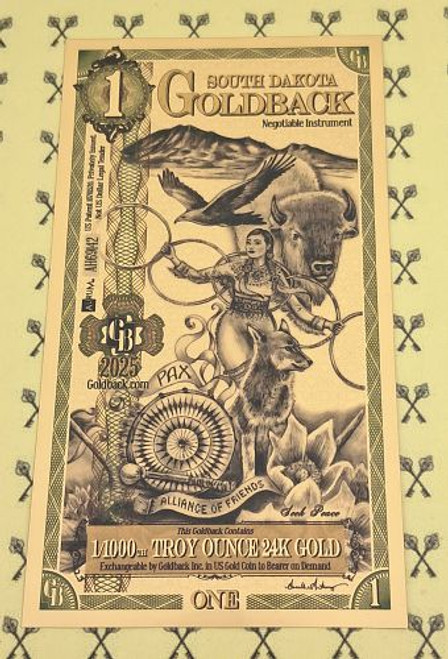
-

-
RESTOCKING

-
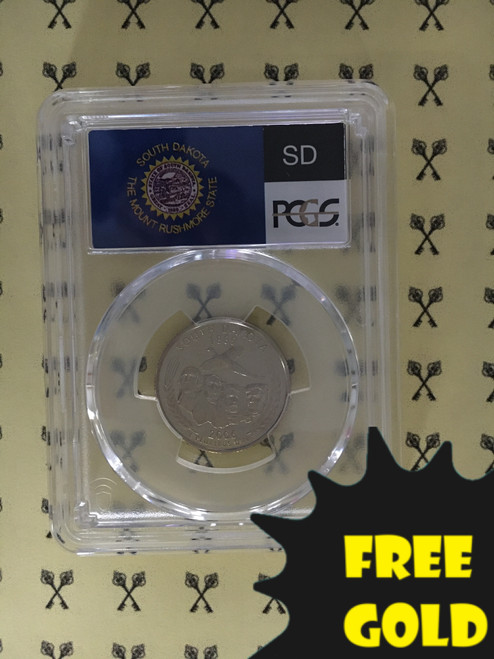
2006-S South Dakota Quarter PCGS PR 69 DCam $19 VALUE with FREE 1/2 GOLDBACK*
MSRP: $19.00$13.57 -

-

-

-

-

-
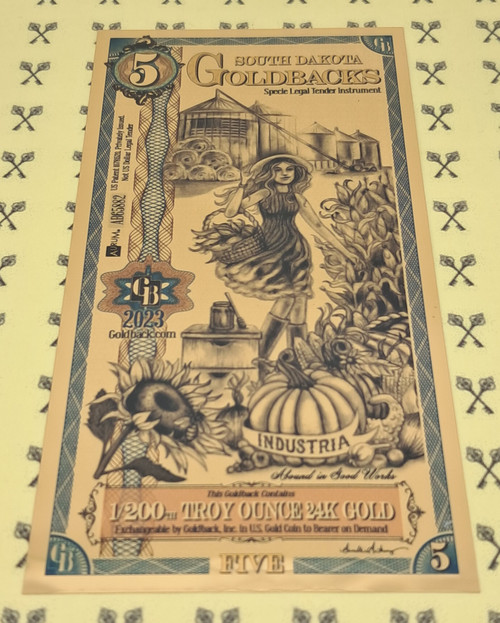
-

-
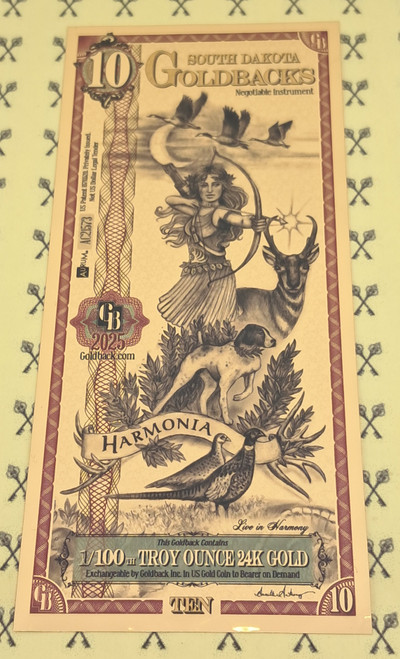
South Dakota
Will South Dakota be the next state to get a Half Goldback?
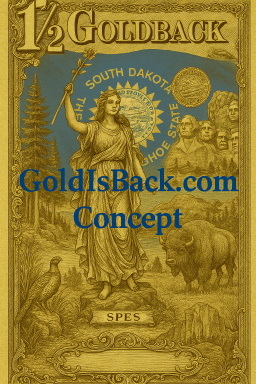
South Dakota Half (1/2) Goldback Concept. Click the image to see all available 0.5 Goldbacks for sale.
Overview of South Dakota Goldback Production
Introduced in 2023 and continue through 2025, the South Dakota Goldback series is accepted at these SD locations. We also sell South Dakota coins. Show pride in your state by getting real SD Bullion.
Artistic Interpretations of the South Dakota Goldback notes
1 - Pax (Peace)
Summary
- Virtue Depicted: Pax, meaning Peace, is represented as a Lakota Native American woman performing a hoop dance in traditional regalia.
- Theme: Inspired by a Lakota performer’s demonstration and teachings, emphasizing peace through harmony and treating all beings—humans, animals, plants, and elements—as relatives.
- Key Elements in Design:
- Lakota Heritage: Regalia symbolizing personal identity, heritage, and tribe, reflecting the Lakota, Nakota, and Dakota ethos of "The Friendly Ones" or "Alliance of Friends."
- Bear Butte (Mato Paha): Sacred formation in the background, significant to Lakota spirituality.
- Sacred Elements: Representation of the seven sacred elements—land, air, water, rocks, animals, plants, and fire—highlighting interconnectedness.
- Prairie Crocus (Pasque Flower): Symbol of life’s cycles, blooming early in spring and completing its life cycle in two weeks, reflecting the brevity and continuity of life.
- Drum and Medicine Wheel: Traditional symbols tied to Lakota spirituality and peace.
Symbolism
- Hoop Dance: Represents creating harmony and peace with everything around oneself.
- Seven Sacred Elements: Highlight the importance of balance and respect for all aspects of the natural world.
- Prairie Crocus: Cyclical nature of life, underscoring the fleeting yet significant connection between generations.
- Message: Through the caption “Seek Peace,” the design calls for cultivating harmony with all beings.
5 - Industria (Industry)
Key Details:
- Virtue Represented: Industria (Industry)
- Setting: A woman walking through a farm field in late summer, surrounded by abundant produce such as corn, sunflowers, pumpkins, and wheat, with grain silos in the background.
- Caption: “Abound in Good Works,” urging joy and diligence in labor.
- Backdrop Inspiration: The plains of South Dakota, reflecting its agricultural heritage and the resilience of early settlers.
Symbolism:
- Sunflowers:
- Represent hard work and credibility.
- Symbolize looking towards light and truth, as they turn towards the sun.
- Encourage abundance and teaching future generations values of growth.
- Honey:
- Represents generational effort and the fruits of collective labor.
- Symbolizes the American dream achieved through industry and cooperation.
- Highlights the importance of bees for pollination and sustaining life.
- Cornucopia: Depicts abundance and prosperity resulting from diligent work.
- Silos and Grain:
- Showcase the rewards of sustained effort and agricultural success.
- One silo features "Old Glory," connecting industry to patriotism and national pride.
Message:
Celebrate the joy in productive labor, teaching future generations the value of hard work. Follow the example of industrious symbols like honey bees to bring about fruitful harvests while appreciating current blessings.
10 - Harmonia (Harmony)
Summary
- Virtue Depiction: Harmonia, inspired by Artemis (the Greco-Roman goddess of the hunt and wilderness), symbolizes harmony in nature. She is depicted with a drawn bow and arrow, surrounded by wildlife and a crescent moon.
- Symbols of Nature and Hunting:
- Animals: Canada geese, pronghorn antelope, mule deer antler sheds, and ring-necked pheasants reflect South Dakota's rich wildlife and hunting traditions.
- Crescent Moon: Symbolizes healing and light amidst darkness.
- Hunting Dog with Laurel Collar: Represents purpose, obedience, and unity of effort.
- Symbols of Womanhood:
- Belt with Diamonds and Feathers:
- Diamonds symbolize the inherent value of women to humanity.
- Feathers represent South Dakota's bird species and highlight the sacredness of womanhood and childbirth.
- Belt with Diamonds and Feathers:
- Ecological Balance: Harmonia embodies the balance between wilderness and human activity, emphasizing the importance of hunting and conservation practices for a thriving ecosystem.
- Bow and Arrow:
- Bow: Represents discipline and practice, symbolizing preparation and intent.
- Arrow: Symbolizes direction, focus, and precision.
- Together, they signify the harmony of effort and purpose, leading to success.
- Crown of Laurel Leaves: Represents victory, achievement, and dedication to one's goals.
- Key Inscription: "Live in Harmony" emphasizes unity, balance, and purposeful living.
Symbolism Highlighted
Harmonia's design is a tribute to ecological harmony, the sacredness of womanhood, and the discipline required to achieve goals. It integrates the balance between nature, humanity, and purposeful actions, reflecting South Dakota's cultural and environmental values.
25 - Laurea (Honor)
Key Points:
- Virtue Represented: Laurea symbolizes Honor.
- Inspiration: Based on the legend of Minnecotah and Maiden’s Isle on Lake Kampeska.
- Legend Summary:
- Minnecotah, a young woman, remained true to her love from Wahpeton despite pressure from local suitors.
- To delay choosing a suitor, she proposed a contest of stone-throwing into the lake, resulting in the creation of an island.
- When the suitors discovered her ruse, they stranded her on the island to force a decision.
- A white pelican sustained her with fish and berries until her true love returned to rescue her.
- The suitors believed the sun god had intervened to save her.
Symbolism:
- Laurea's Stance: Standing on a stone island symbolizes Maiden’s Isle, representing perseverance and honor.
- White Pelican: Represents divine providence and protection during trials.
- Raspberries in the Foreground: Symbolize sustenance and survival through challenges.
- Lakota Cultural Legends:
- Includes elements of the flute, porcupine quills, and dream catcher to honor the broader cultural significance of keeping promises and staying true to one’s word.
- Inscription: "Honor to the Giver" reminds viewers to show gratitude and honor the Creator through life's trials.
50 - Libertas (Liberty)
- Libertas' Representation:
- Depicted as inspired by the Lady Freedom statue in D.C.
- Holds a bared sword (readiness to protect) and a shield bearing her name, the South Dakota flag’s sun, and the state motto: “Under God the People Rule.”
- Crested helmet, shield, and sword symbolize Roman goddesses Minerva and Bellona, embodying wisdom and war readiness.
- Symbols and Their Meanings:
- Bison Skull with Medicine Wheel:
- Represents the Lakota Sioux and other native peoples of South Dakota.
- Symbolizes hope, healing, and the sacredness of life and sacrifice.
- Freesia Flower Cluster:
- Stands for peace, friendship, and innocence.
- Bison Skull with Medicine Wheel:
- Background Elements:
- Fisherman catching walleye (state fish) near Palisades State Park.
- South Dakota State Capitol.
- Black Hills’ Needles formations in Custer State Park.
- Mount Rushmore symbolizing America, Freedom, and Hope.
- Message of Libertas:
- Encourages steadfastness in liberty with the phrase “Stand Fast in Liberty.”
Symbolism Highlights
- Sword and Shield: Readiness to defend freedom.
- Medicine Wheel on Bison Skull: Healing, unity, and sacred traditions of indigenous cultures.
- Mount Rushmore and Capitol: National and state symbols of governance and freedom.
- Freesia Flowers: Innocence and peace within liberty.
History of Gold in South Dakota
South Dakota's gold history is deeply tied to one of the most famous gold rushes in American history. The Black Hills Gold Rush not only shaped the state’s economy but also played a pivotal role in U.S. expansion and conflict with Native American tribes.
Early Gold Sightings
Gold was likely known to Native American tribes long before European settlers arrived, but formal reports began emerging in the early 1800s. However, it wasn’t until the 1870s that gold discoveries gained national attention and spurred migration to the region.
The Black Hills Gold Rush (1874–1876)
The turning point came in 1874 when General George Custer led the Black Hills Expedition and reported significant gold deposits. Although the land was protected by treaty with the Lakota Sioux, the report triggered a gold rush. By 1876, thousands of prospectors had poured into the area, founding towns like Deadwood and Lead.
The Homestake Mine
The discovery of the Homestake Mine near Lead in 1876 would prove to be monumental. It became the largest and deepest gold mine in North America and operated continuously for over 125 years. At its peak, it produced more than 40 million ounces of gold, shaping South Dakota’s economy and mining legacy.
Gold, Conflict, and Consequences
The gold rush in South Dakota was not without controversy. The influx of miners violated the Fort Laramie Treaty of 1868, which had guaranteed the Black Hills to the Lakota. This led to increased tensions and armed conflicts, most notably the Great Sioux War of 1876. The U.S. eventually seized the Black Hills, a decision still disputed today.
Modern-Day Mining and Legacy
While the Homestake Mine ceased operations in 2002, interest in gold in South Dakota remains strong. The Black Hills continue to draw prospectors, hobbyists, and tourists. The area’s rich history, combined with lingering gold deposits, makes it a focal point for both mining and heritage tourism. New exploration and technology could revive commercial gold operations in the near future.
Conclusion
South Dakota’s golden legacy is a powerful story of discovery, innovation, conflict, and resilience. The Black Hills stand not only as a symbol of the American gold rush spirit but also as a reminder of the complex history between economic ambition and indigenous rights.